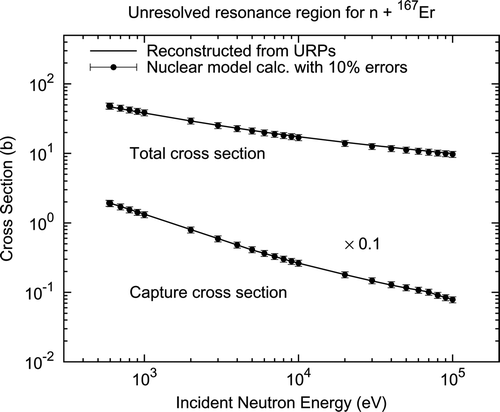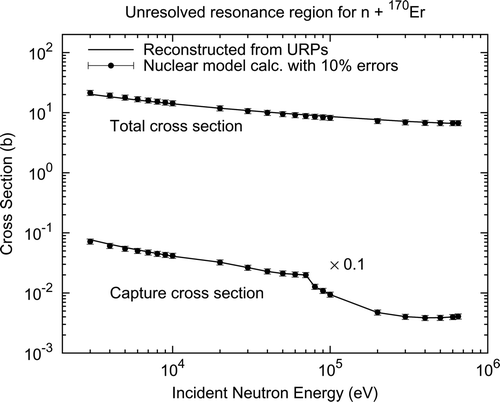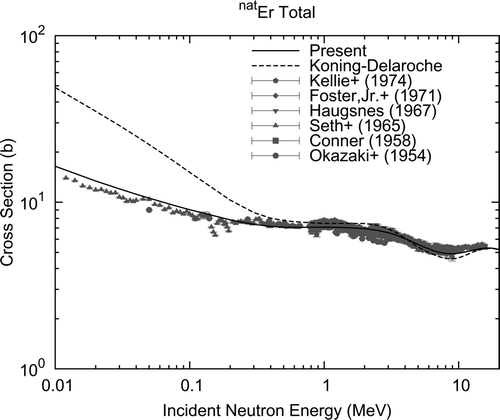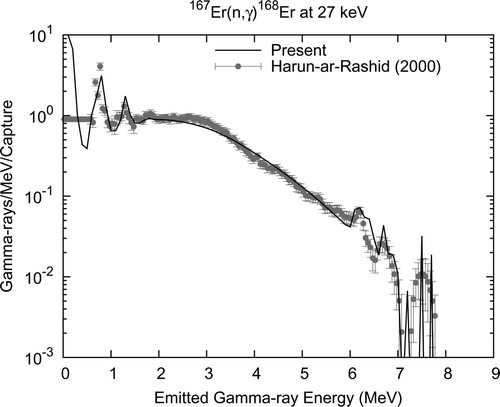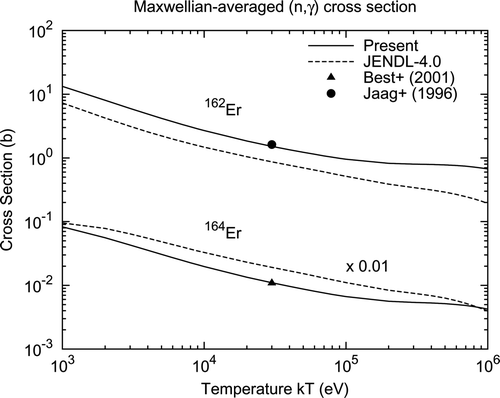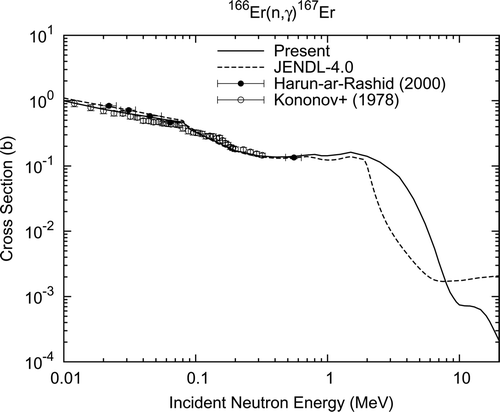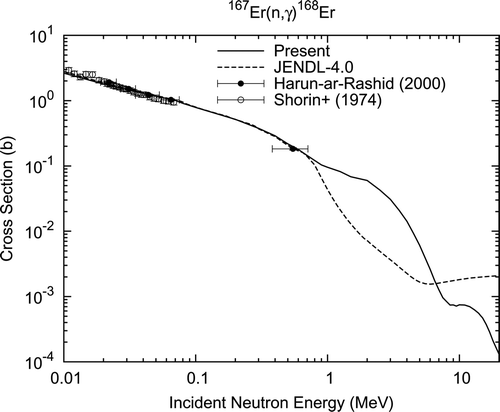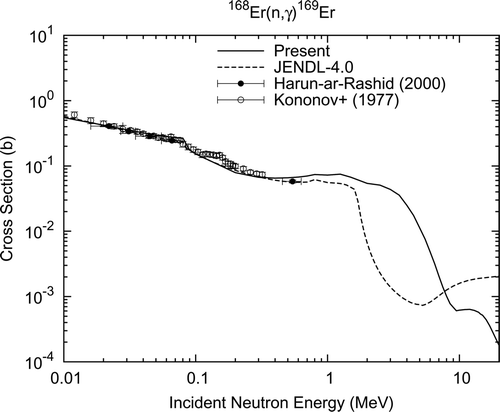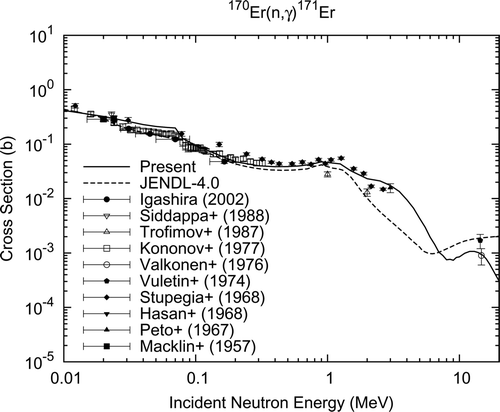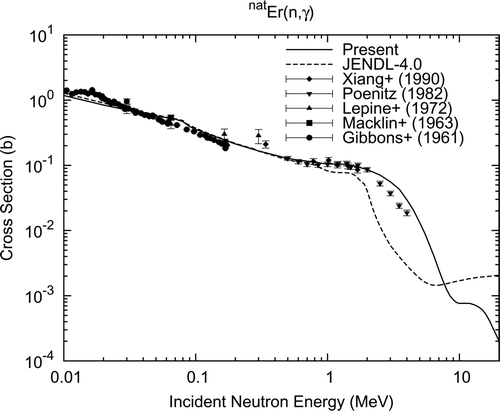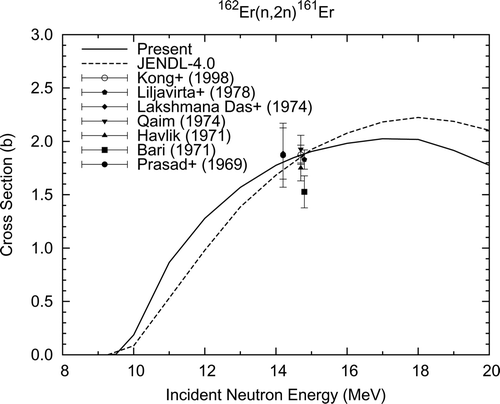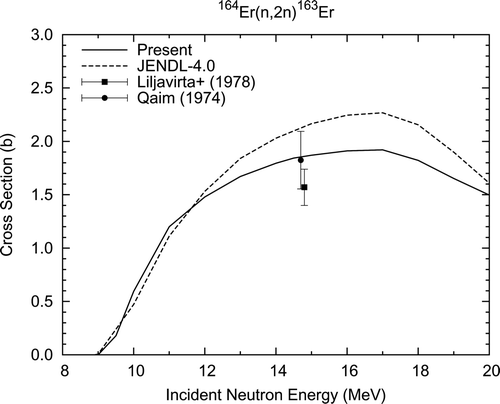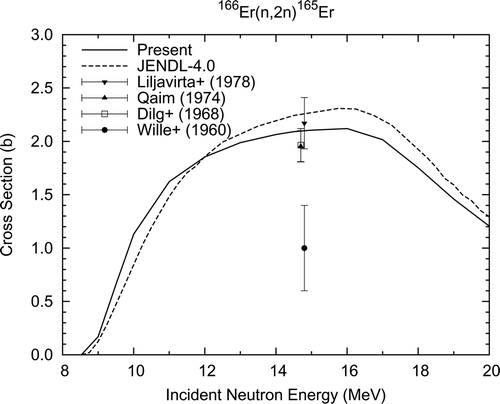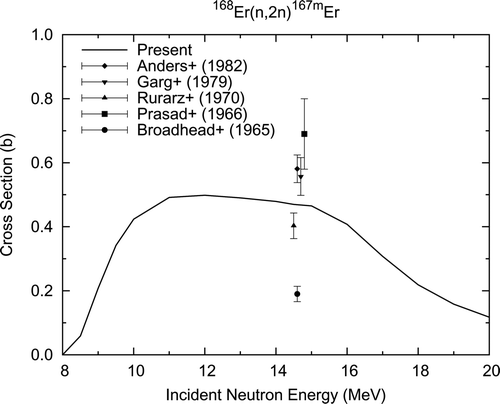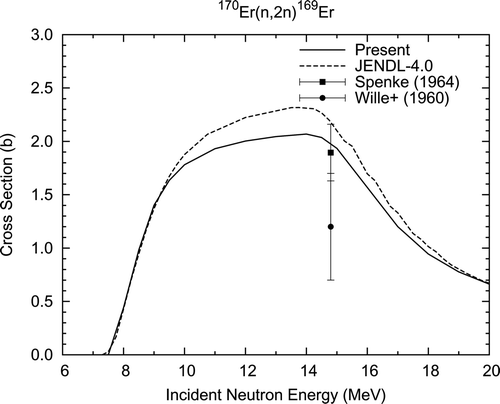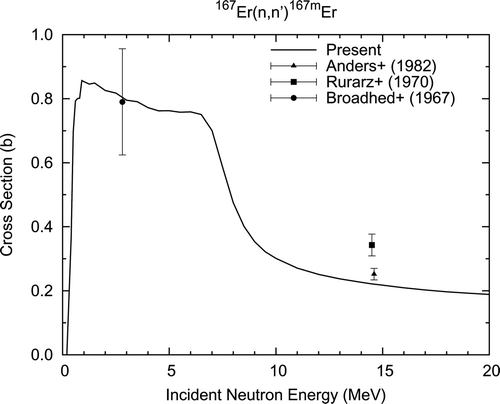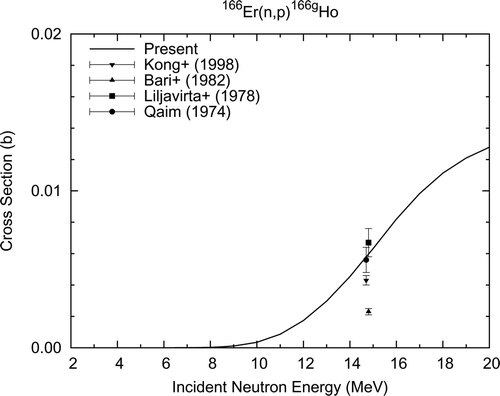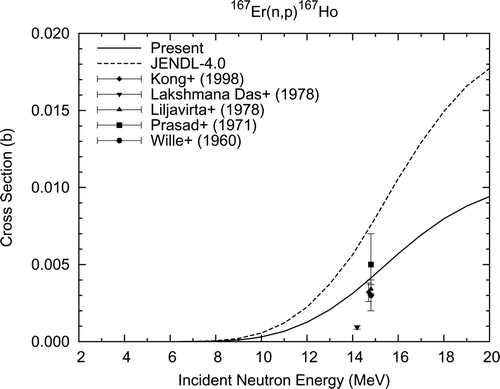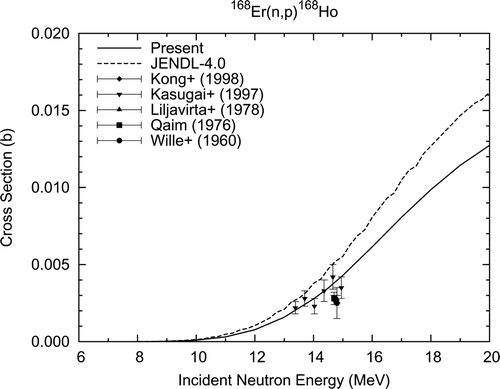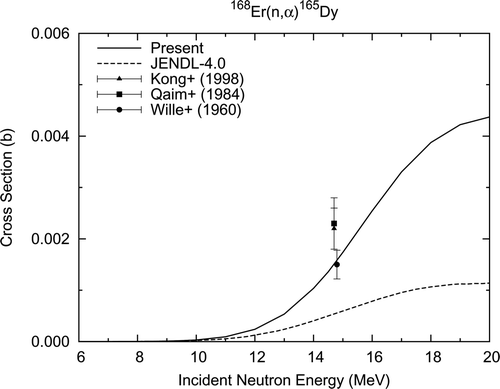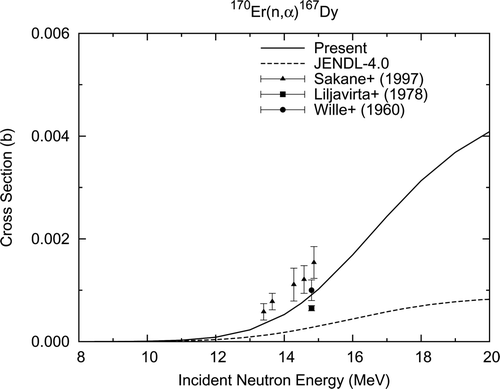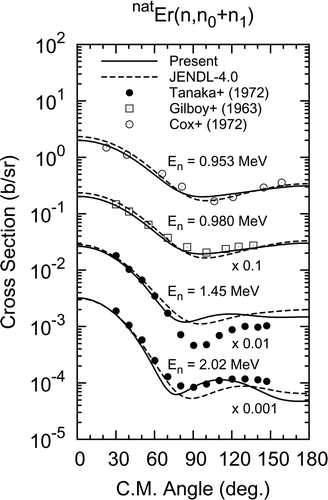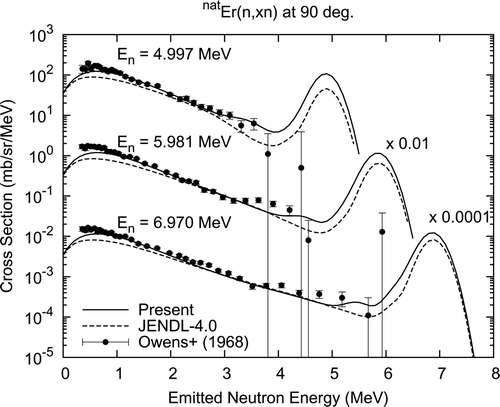Abstract
Neutron nuclear data on 162,164,166,167,168.170Er have been evaluated for the next version of JENDL general purpose file in the energy region from 10−5 eV to 20 MeV. The resolved resonance parameters remain unchanged from JENDL-4.0, while the unresolved resonance parameters were revised. The statistical model was applied to calculate the cross sections above the resolved resonance region. In the calculations, coupled-channel optical model parameters were used for neutrons. Pre-equilibrium and direct-reaction processes were taken into account in addition to the compound process. A modified Lorentzian was employed for E1 gamma-ray strength functions. The present evaluation is consistent with available experimental data. The evaluated data are compiled into an ENDF-formatted data file.
1. Introduction
The fourth version of the Japanese Evaluated Nuclear Data Library (JENDL-4.0 [Citation1]) was released in May 2010. In this library, 215 nuclides are regarded as fission products in the region from Z = 30 to 68. Although the resolved resonance parameters were examined by reviewing experimental data for all of those nuclides, the fast neutron region above resolved resonances was re-evaluated for 174 nuclides due to time limit. Therefore, the fast-neutron cross sections for the remaining 41 nuclides may need improvements for the next version of JENDL general purpose file. Erbium isotopes are among the 41 nuclides. More importantly, erbium is a candidate for burnable poisons in fission reactors. It is required to re-examine the cross sections of erbium.
Erbium data were evaluated [Citation2] for JENDL-3.3 [Citation3] in 2000. Since then, minor modifications were done for JENDL-4.0 in the resonance region. In the 2000 evaluation, the statistical-model code CASTHY [Citation4] was used to calculate the total, elastic and inelastic scattering and capture cross sections, while the cross sections for the competing reactions such as (n, 2n) and (n, p) were obtained from the Hauser-Feshbach [Citation5] code GNASH [Citation6]. The direct inelastic scattering was considered only for the first excited states of even–even isotopes, while it was taken into account for five excited states of 167Er.
This study was undertaken to improve the evaluated data on erbium isotopes by considering the latest knowledge on experimental and theoretical nuclear physics. Evaluated are the total, elastic and inelastic scattering, (n, γ), (n, p), (n, d), (n, t), (n,3He), (n, α), (n, np), (n, nd), (n, nα), (n, 2n), (n, 3n) reaction cross sections, the angular distributions of emitted neutrons and charged-particles, and the energy distributions of emitted particles and γ -rays in the incident-neutron energy region from 10−5 eV to 20 MeV. The Q-values of the reactions were calculated from the latest version of the mass table (AME2003) obtained by Audi et al. [Citation7] and are listed in , together with isotopic abundances [Citation8]. The unresolved resonance parameters were obtained by fitting to the calculated total and (n, γ) cross sections.
Table 1. Isotopic abundances and reaction Q-values of erbium isotopes.
This article presents how the evaluation was performed. Section II deals with the resonance parameters. In section 3, the computational methods and procedures are described. Comparisons of the evaluated results with available experimental data and evaluated data are made in section 4. Finally, section 5 summarizes the conclusion.
2. Resonance parameters
The resolved and unresolved resonance regions are given in for each target nucleus. After the compilation of JENDL-4.0, new resolved resonance parameters for 166,167,168,170Er were published by Wang et al. [Citation9] from the analyses of their transmission measurements on elemental erbium. Using their parameters for 167Er, however, the calculated thermal capture cross section of 167Er is about 10% larger than the value of JENDL-4.0 (644.2 b at 300 K). This large change is unacceptable by considering the results of the sample worth analyses [Citation10] of Er2O3. As a result, the resolved resonance parameters remain unchanged from JENDL-4.0.
Table 2. Resolved and unresolved resonance regions.
The ASREP code [Citation11] was used to determine the unresolved resonance parameters (URPs) by fitting to the total and capture cross sections evaluated by the nuclear model calculations described in the following section. It should be noted that the URPs obtained are used only for self-shielding calculations, since the point-wise cross sections are given in the evaluated data files. As examples, the cross sections of 167Er and 170Er reconstructed from the URPs presently obtained are compared with the total and capture cross sections calculated from the nuclear models in and , respectively. In the parameter fitting, 10% errors of the nuclear model calculations were assumed. It is found from the figures that the reconstructed cross sections reproduce the nuclear model calculations very well.
3. Computational methods and procedures above resonance region
3.1. Nuclear models
The POD code [Citation12] was used for calculating the neutron-induced reaction cross sections of erbium isotopes. The code is based on the spherical optical model, the one-component exciton pre-equilibrium model, the distorted-wave Born approximation (DWBA) and the multistep statistical model. In order to simulate the direct and semidirect effects on the capture reaction, the pre-equilibrium capture was considered by using the γ-ray emission rate derived by Akkermans and Gruppelaar [Citation13]. The original POD code was modified to allow for options of γ-ray strength functions, i.e. generalized, extended generalized and modified Lorentzians [Citation14,Citation15] (GLO, EGLO and MLO, respectively) for E1 radiation, in addition to the standard Lorentzian (SLO).
The POD code is not capable of calculating direct reaction cross sections and transmission coefficients by the coupled-channel method. These two kinds of data are supplied to POD by a separate coupled-channel code if the use of the coupled-channel method is preferable. In the present study, the coupled-channel optical model code OPTMAN [Citation16] supplied those values to the POD code.
3.2. Parameter determination
3.2.1. Optical-model potentials
We employed the global neutron optical-model parameters obtained by Kunieda et al. [Citation17] using the coupled-channel method based on the rigid-rotator model (RRM) [Citation18] with a slight modification. The values were changed to −38.0 MeV for 162,164,166,167Er and to −38.4 MeV for 168,170Er, which amount to changes less than 1% as compared with the original values. The coupled-channel method based on the soft-rotator model (SRM) [Citation16] was applied to calculate the transmission coefficients, and the total and direct-reaction cross sections of even–even targets, since the SRM could consider vibrational modes in addition to rotational ones. The coupling schemes and deformation parameters are listed in and , respectively. The calculated total cross section of elemental Er is illustrated in , together with experimental data and the spherical optical model calculations using the parameters of Koning and Delaroche [Citation19]. It is found from the figure that the present calculations are in good agreement with the experimental data in the entire energy region. The spherical optical model parameters of Koning and Delaroche yield large cross sections in the low energy region. Built-in values in POD were used for charged-particle optical-model parameters, i.e. the values of Koning and Delaroche [Citation19] for protons, those of Lohr and Haeberli [Citation20] for deuterons, those of Becchetti and Greenlees [Citation21] for tritons and 3He, and those of Lemos [Citation22] potentials modified by Arthur and Young [Citation23] for α-particles. The values of Lohr–Haeberli and Becchetti–Greenlees potentials were actually taken from the compilation of Perey and Perey [Citation24].
Table 3. Coupling schemes used in the interaction between neutron and target.
Table 4. Deformation parameters in the coupled-channel calculation.
3.2.2. Discrete levels and level density
In the present calculation, it was necessary to input the discrete levels and level density parameters for 34 nuclei, i.e. 160–171Er, 160–170Ho and 158–168Dy. The discrete levels were taken from the reference input parameter library RIPL-3 [Citation25].
Concerning the level density, the composite formula of Gilbert and Cameron [Citation26] was used in the present work. In the region of low excitation energy E, the level density is described by the constant temperature formula ρ T , namely,
On the other hand, the a parameter, which characterizes the Fermi-gas part of level density ρ F , is defined as:
Table 5. Level density parameters for each nucleus.
3.2.3. Gamma-ray transition
The SLO γ -ray strength function is solely available in the original POD code. The options for GLO and EGLO were added for E1 radiation in the previous work [Citation29–Citation31]. Recently, further modification was done to allow for a new option MLO, which is recommended to use in RIPL-3 [Citation25]. The MLO form was used in the present work. The giant resonance parameters for E1 were taken from RIPL-3, where the parameters were obtained by a fit of theoretical photo-absorption cross sections to experimental data. Unless the parameters are available for particular nucleus in RIPL-3, one can use the systematics given in Ref. [Citation25]. Moreover, a pygmy resonance was considered for E1 radiations of the compound nuclei. The parameters of the pygmy resonance were determined from the systematic trend obtained by Igashira et al. [Citation32], namely, a peak cross section of 0.5 mb, a resonance energy of 3.5 MeV and a width of 1.0 MeV. The resonance energy and width parameters for M1 and E2 are also obtained from another systematics [Citation33] and given by
The symbol A stands for the mass number of a nucleus. The contributions of M1 and E2 relative to E1 were estimated [Citation6] such as
shows the relative capture gamma-ray spectrum for 167Er at an incident neutron energy of 27 keV. The present calculations reproduce the data measured by Harun-ar-Rashid [Citation2,Citation34] satisfactorily, which indicates that the present choice of gamma-ray strength functions is reasonable. As for the compound nuclei 167,168,169,171Er, the strength functions are normalized so as to reproduce measured capture cross sections of the corresponding target nuclei around several tens of keV. For 163,165Er, Maxwellian-averaged capture cross sections [Citation35,Citation36] at kT = 30 keV were used for the normalization, since the data measured using mono-energetic neutrons are very scarce above the keV region. The s-wave γ-ray strength functions Sγ0 obtained are compared in with the values recommended by Mughabghab [Citation37]. Except for 163Er, the present values are almost consistent with the ones given by Mughabghab. Using a theoretical value [Citation37] of the average total radiative width <Γγ0> = 71 meV for 163Er, the gamma-ray strength function would be equal to 103 ± 18, which is not far from the present value. Normalization factors for other nuclei were obtained by using the calculated average level spacing D 0 for s-wave neutrons and the thermodynamical formula of <Γγ0> for s-wave neutrons. The latter quantity is expressed [Citation38] by
Table 6. Gamma-ray strength functions for s-wave neutron in units of 10−4.
3.2.4. Pre-equilibrium parameters
For pre-equilibrium capture, SLO-shaped photon absorption cross sections are required [Citation13] to calculate the γ -ray emission rate. The peak cross section, resonance energy and resonance width are calculated from the systematics [Citation25]. If the experimentally-determined parameters are available in RIPL-3, the systematics is replaced with them. The single-particle state density g, which is required to describe the pre-equilibrium state density for a residual nucleus, is set to A/13 MeV−1 for all nuclei but 167,168,169Ho and 165,167Dy. Comparing with measured charged-particle emission data, the g values were adjusted for these residual nuclei, i.e. 10.0, 10.5, 10.5, 15.5 and 14.5 MeV−1 for 167,168,169Ho and 165,167Dy, respectively. There remain three kinds of normalization parameters for pre-equilibrium particle emission in the POD code: K, which determines the absolute square of the average matrix element for the residual two-body interaction and the scale factors for a pickup reaction and α-particle knockout, K pickup and K knockout. These parameters were determined so as to fit to the measured cross sections. The values obtained are listed in .
Table 7. Pre-equilibrium parameters used in the present work.
4. Comparison with experimental and other evaluated data in fast neutron energy region
The presently evaluated data are compared with experimental and other evaluated data. The experimental data are taken from the EXFOR database [Citation39], which is available in the international data centres such as the OECD/NEA Data Bank. As for the general-purpose nuclear data, there are three major libraries, i.e. JENDL-4.0 [Citation1], ENDF/B-VII.1 [Citation40] and JEFF-3.1.2. [Citation41] As for JEFF-3.1.2, the whole data of erbium isotopes were taken from JENDL-3.3. The resonance parameters of 166,167,168,170Er for ENDF/B-VII.1 were independently evaluated, although the other data for ENDF/B-VII.1 were taken from JENDL-3.3. As described in section 1, the erbium data of JENDL-4.0 are based on those of JENDL-3.3 with modifications of resonance regions. Thus, in the fast neutron energy region, JENDL-4.0, ENDF/B-VII.1 and JEFF-3.1.2 are all equivalent as far as erbium is concerned. Therefore, the JENDL-4.0 data are solely drawn in the following figures as existing evaluated data. It should be noted that the general-purpose libraries do not contain any partial activation cross sections leading to the ground or isomeric state.
As mentioned in the previous section, experimental data on the radiative capture cross sections of 162,164Er are very scarce above the keV region. The Maxwellian-averaged data [Citation35,Citation36] were used to normalize the present statistical model calculations, as shown in . It is found from the figure that the JENDL-4.0 evaluations deviate from the measurements. The radiative capture cross sections of 166,167,168,170Er are illustrated in –, respectively. The present evaluations are almost consistent with available experimental data. Concerning 170Er, the JENDL-4.0 evaluation reproduces the experimental data better than the present one in the region from 30 to 80 keV. As a matter of fact, the statistical model calculations done for JENDL-3.3 were almost the same as the present ones, and could not reproduce the experimental data. Finally, the calculations were modified by following the data measured by Igashira [Citation42]. In the present work, we tried to solve the discrepancy between the measured and calculated data in this particular energy region by changing model parameters such as optical model and level-density parameters. However, none of these efforts were successful. Therefore, we gave up fitting the calculations to the measurements, and adopted the calculations as the evaluated data. More new measurements might be needed to solve the discrepancy. There is a difference between the present evaluation and JENDL-4.0 in the MeV region, although no measurements are available except for 170Er. According to the radiative capture cross sections of elemental Er shown in , the present calculations almost reproduce the experimental behaviour in the MeV region.
The (n, 2n) reaction cross sections are illustrated in –. The present evaluations are somewhat smaller than the JENDL-4.0 cross sections in the high energy region, although the 168Er (n, 2n)167m Er cross section is not contained in JENDL-4.0. shows the cross section for the activation reaction 167Er (n, n′)167m Er. In order to enhance the activation cross section particularly above 10 MeV, the vibrational excitation was considered by using DWBA for several low-lying levels of 167Er, since the OPTMAN code [Citation16] is not capable of taking account of vibrational levels for odd nuclei with the RRM.
The charged-particle emission cross sections are shown in –. It is found from these figures that the presently evaluated cross sections are in good agreement with the measured data. It should be noted that the pre-equilibrium mode was enhanced in order to reproduce the measured composite-particle emission data for 168,170Er, as seen in . In all cases, the JENDL-4.0 evaluations differ from the measurements.
and show the angular distributions of neutrons elastically scattered from elemental erbium. The figures include the contributions of the neutrons inelastically scattered from the first excited states of individual isotopes, since the energies of the first excited states are mostly less than 100 keV, which is smaller than typical experimental resolutions. The present evaluation is in good agreement with the measured data. The evaluated neutron emission spectra for elemental erbium are compared in with the experimental data measured by Owens and Towle [Citation43] and the JENDL-4.0 evaluation. The present evaluation agrees with the measurements, while the JENDL-4.0 evaluation is smaller than the measured data below 2 MeV. The difference in the evaluated spectra comes from the neutrons inelastically scattered from continuum levels of the target nuclei.
5. Concluding remarks
The neutron nuclear data of erbium isotopes were evaluated in the energy region from 10−5 eV to 20 MeV. It was found that the new resolved resonance parameters, which were obtained from the analysis of transmission measurements, yielded large thermal capture cross section of 167Er. Therefore, it was decided that the resolved resonance parameters remained unchanged from JENDL-4.0. On the other hand, the unresolved resonance parameters were revised by fitting to the total and capture cross sections calculated from the nuclear models.
Above the resolved resonance region, the present evaluation is mainly based on the statistical model using the POD code. The neutron transmission coefficients were obtained by the coupled-channel method, together with the total cross sections, the shape elastic scattering cross sections and the direct-reaction components of the inelastic scattering cross sections. The E1 gamma-ray strength functions were determined by comparing with measured gamma-ray spectra. The presently evaluated cross sections are in good agreement with available experimental data. The evaluated data are compiled into an ENDF-formatted data file.
Acknowledgement
The author would like to thank the members of the Nuclear Data Center, Japan Atomic Energy Agency, for their helpful comments on this work.
References
- Shibata , K. , Iwamoto , O. , Nakagawa , T. , Iwamoto , N. , Ichihara , A. , Kunieda , S. , Chiba , S. , Furutaka , K. , Otuka , N. , Ohsawa , T. , Murata , T. , Matsunobu , H. , Zukeran , A. , Kamada , S. and Katakura , J. 2011 . JENDL-4.0: A new library for nuclear science and engineering . J. Nucl. Sci. Technol , 48 : 1 – 30 .
- Harun-ar-Rashid , A.K.M. 2000 . Study on neutron reaction cross sections of Erbium isotopes up to 20 MeV , Tokyo Institute of Technology . Ph.D. Thesis
- Shibata , K. , Kawano , T. , Nakagawa , T. , Iwamoto , O. , Katakura , J. , Fukahori , T. , Chiba , S. , Hasegawa , A. , Murata , T. , Matsunobu , H. , Ohsawa , T. , Nakajima , Y. , Yoshida , T. , Zukeran , A. , Kawai , M. , Baba , M. , Ishikawa , M. , Asami , T. , Watanabe , T. , Watanabe , Y. , Igashira , M. , Yamamuro , N. , Kitazawa , H. , Yamano , N. and Takano , H. 2002 . Japanese evaluated nuclear data library version 3 revision-3: JENDL-3.3 . J. Nucl. Sci. Technol , 39 : 1125 – 1136 .
- Igarasi , S. and Fukahori , T. 1991 . Program CASTHY – Statistical Model Calculation for Neutron Cross Sections and Gamma Ray Spectrum– , Tokai, Japan : Japan Atomic Energy Research Institute . JAERI 1321
- Hauser , W. and Feshbach , H. 1952 . The inelastic scattering of neutrons . Phys. Rev , 87 : 366 – 373 .
- Young , P.G. , Arthur , E.D. and Chadwick , M.B. 1992 . Comprehensive Nuclear Model Calculations: Introduction to the Theory and Use of the GNASH Code , Los Alamos, NM, USA : Los Alamos National Laboratory . LA-12343-MS
- Audi , G. , H. Wapstra , A. and Thibault , C. 2003 . The AME2003 atomic mass evaluation (II). tables, graphs and references . Nucl. Phys , A 729 : 337 – 676 .
- Berglund , M. and Wieser , M.E. 2011 . Isotopic compositions of the elements 2009 (IUPAC technical report) . Pure Appl. Chem , 83 : 397 – 410 .
- Wang , T. , Lee , M. , Kim , K.S. , Kim , G. , Oh , Y.D. , Cho , M.H. , Ko , I.S. , Namkung , W. and Ro , T.I. 2010 . Measurements of neutron total cross-sections and resonance parameters of erbium at the Pohang Neutron Facility . Nucl. Inst. Meth. B , 268 : 106 – 113 .
- Ieyama , K. , Shimozato , K. and Kitada , T. Analysis of sample worth for Dy2O3, Ho2O3, Er2O3 and Tm2O3 measured at KUCA by MVP with recent version of JENDL, ENDF and JEFF . Proceedings of the 2010 Symposium on Nuclear Data . November 25–26 2010 . pp. 229 – 233 . Japan : Japan Atomic Energy Agency . JAERI-Conf 2011-002
- Kikuchi , Y. , Nakagawa , T. and Nakajima , Y. 1999 . ASREP: A Computer Program for Automatic Search of Unresolved Resonance Parameters , Japan Atomic Energy Research Institute . JAERI-Data/Code 99-025 (in Japanese)
- Ichihara , A. , Iwamoto , O. , Chiba , S. , Kunieda , S. and Shibata , K. 2007 . Program POD; A Computer Code to Calculate Cross Sections for Neutron-Induced Nuclear Reactions , Japan Atomic Energy Agency . JAEA-Data/Code 2007-012
- Akkermans , J.M. and Gruppelaar , H. 1985 . Analysis of continuum gamma-ray emission in precompound-decay reactions . Phys. Lett , B 157 : 95 – 100 .
- Kopecky , J. , Uhl , M. and Chrien , R.E. 1993 . Radiative strength in the compound nucleus 157Gd . Phys. Rev , C 47 : 312 – 322 .
- Plujko , V.A. , Ezhov , S.N. , Kavatsyuk , M.O. , Grebenyuk , A.A. and Yermolenko , R.V. 2002 . Testing and improvements of gamma-ray strength functions for nuclear model calculations . J. Nucl. Sci. Technol , : 811 – 814 .
- Soukhovitski , E.S. , Chiba , S. , Iwamoto , O. , Shibata , K. , Fukahori , T. and Morogovskij , G.B. 2005 . Programs of OPTMAN and SHEMMAN Version 8 (2004) , Japan : Japan Atomic Energy Research Institute . JAERI-Data/Code 2005-002
- Kunieda , S. , Chiba , S. , Shibata , K. , Ichihara , A. and Sukhovitskiĩ , E.S. 2007 . Coupled-channels optical model analyses of nucleon-induced reactions for medium and heavy nuclei in the energy region from 1 keV to 200 MeV . J. Nucl. Sci. Technol , 44 : 838 – 852 .
- Tamura , T. 1965 . Analyses of the scattering of nuclear particles by collective nuclei in terms of the coupled-channel calculation . Rev. Mod. Phys , 37 : 679 – 708 .
- Koning , A.J. and Delaroche , J.P. 2003 . Local and global nucleon optical models from 1 keV to 200 MeV . Nucl. Phys , A 713 : 231 – 310 .
- Lohr , J.M. and Haeberli , W. 1974 . Elastic scattering of 9–13 MeV vector polarized deuterons . Nucl. Phys , A 232 : 381 – 397 .
- Becchetti , F.D. , Jr. and and Greenlees , G.W. A global set of 3 He and Triton optical-model potentials for A > 40, E < 40 MeV . Proceedings of the Third International Symposium on Polarization Phenomena in Nuclear Reactions . 31 August–4 September 1970 . Edited by: Barshall , H.H. and Haeberli , W. pp. 682 – 683 . University of Wisconsin Press .
- Lemos , O.F. 1972 . Diffusion Elastique de Particules Alpha de 21–29.6 MeV sur des Noyaux de la Region Ti-Zn Orsay report, Series A., No. 136
- Arthur , E.D. and Young , P.G. 1980 . Evaluated neutron-induced cross sections for 54,56 Fe to 40 MeV , Los Alamos, NM, USA : Los Alamos National Laboratory . LA-8626-MS
- Perey , C.M. and Perey , F.G. 1976 . Compilation of phenomenological optical-model parameters 1954–1975 . At. Data Nucl. Data Tables , 17 : 1 – 101 .
- Capote , R. , Herman , M. , Obložinský , P. , Young , P.G. , Goriely , S. , Belgaya , T. , Ignatyuk , A.V. , Koning , A.J. , Hilaire , S. , Plujko , V.A. , Avrigeanu , M. , Bersillon , O. , Chadwick , M.B. , Fukahori , T. , Ge , Zhigang , Han , Yinlu , Kailas , S. , Kopecky , J. , Maslov , V.M. , Reffo , G. , Sin , M. , S. Soukhovistskii , E. and Talou , P. 2009 . RIPL – Reference input parameter library for calculations of nuclear reactions and nuclear data evaluations . Nucl. Data Sheets , 110 : 3107 – 3214 .
- Gilbert , A. and Cameron , A.G.W. 1965 . A composite nuclear-level density formula with shell corrections . Can. J. Phys , 43 : 1446 – 1496 .
- Mengoni , A. and Nakajima , Y. 1994 . Fermi-gas model parametrization of nuclear level density . J. Nucl. Sci. Technol , 31 : 151 – 162 .
- Mengoni , A. and Nakajima , Y. 1993 . HERMES: A Personal-Computer Program for Calculation of the Fermi-gas Model Parameters of Nuclear Level Density , Tokai, Japan : Japan Atomic Energy Research Institute . JAERI-M 93-177
- Kamada , S. , Shibata , K. , Ichihara , A. and Kunieda , S. 2010 . Calculation of neutron nuclear data on selenium isotopes for JENDL-4 . J. Nucl. Sci. Technol , 47 : 329 – 339 .
- Shibata , K. , Ichihara , A. and Kunieda , S. 2010 . Calculation of neutron nuclear data on rubidium and strontium isotopes for JENDL-4 . J. Nucl. Sci. Technol , 47 : 1055 – 1064 .
- Shibata , K. , Ichihara , A. and Kunieda , S. 2011 . Evaluation of neutron nuclear data on bromine and krypton isotopes for JENDL-4.0 . J. Nucl. Sci. Technol , 48 : 429 – 439 .
- Igashira , M. , Kitazawa , H. , Shimizu , M. , Komano , H. and Yamamura , N. 1986 . Systematics of the pygmy resonance in keV neutron capture γ-ray spectra of nuclei with N≈82–126 . Nucl. Phys , A 457 : 301 – 316 .
- Kopecky , J. 1998 . Gamma-Ray Strength Functions , 97 – 111 . Vienna, Austria : International Atomic Energy Agency . IAEA-TECDOC-1034
- Harun-ar-Rashid , A.K.M. , Ro , T.I. , Igashira , M. and Ohsaki , T. 2000 . Measurement of keV-neutron capture cross sections and capture gamma-ray spectra of 167Er . J. Nucl. Sci. Technol , 37 : 421 – 427 .
- Jaag , S. and Käppeler , F. 1996 . The stellar . Astrophys. J , 464 : 874 – 883 . n, γ) cross section of the unstable isotope 163Ho and the origin of 164Er
- Best , J. , Stoll , H. , Arlandini , C. , Jaag , S. , Käppeler , F. , Wisshak , K. , Mengoni , A. , Reffo , G. and Rauscher , T. 2001 . s-process branchings at 151Sm, 154Eu, and 163Dy . Phys. Rev , C 64 : 015801-1–015801-15
- Mughabghab , S.F. 2006 . Atlas of Neutron Resonance, Resonance Parameters and Thermal Cross Sections Z = 1–100 , Amsterdam : Elsevier .
- Benzi , V. , Maino , G. , Menapace , E. and Ventura , A. BCS level density calculations and consistent estimate of radiative widths by means of a thermodynamic model . Proceedings of the Specialists' Meeting on Neutron Cross Sections of Fission Product Nuclei . December 12–14 1979 . pp. 215 – 230 .
- Schwerer (Ed.) , O. 2008 . EXFOR Formats Description for Users (EXFOR Basics) , Vienna, Austria : International Atomic Energy Agency . IAEA-NDS-206
- Chadwick , M.B. , Herman , M. , Obložinský , P. , Dunn , M. , Danon , Y. , Kahler , A.C. , Smith , D.L. , Pritychenko , B. , Arbanas , G. , Arcilla , R. , Brewer , R. , Brown , D.A. , Capote , R. , Carlson , A.D. , Cho , Y.S. , Derrien , H. , Guber , K. , Hale , G.M. , Hoblit , S. , Holloway , S. , Johnson , T.D. , Kawano , T. , Kiedrowski , B.C. , Kim , H. , Kunieda , S. , Larson , N.M. , Leal , L. , Lestone , J.P. , Little , R.C. , McCutchan , E.A. , MacFarlane , R.E. , Macinnes , M. , Mattoon , C.M. , McKnight , R.D. , Mughabghab , S.F. , Nobre , G.P.A. , Palmiotti , G. , Palumbo , A. , Pigni , M.T. , Pronyaev , V.G. , Sayer , R.O. , Sonzogni , A.A. , Summers , N.C. , Talou , P. , Thompson , I.J. , Trkov , A. , Vogt , R.L. , van der Marck , S.C. , Wallner , A. , White , M.C. , Wiadra , D. and Young , P.G. 2011 . ENDF/B-VII.1 nuclear data for science and technology: cross sections, covariances, fission product yields and decay data . Nucl. Data Sheets , 112 : 2887 – 2996 .
- “ OECD Nuclear Energy Agency Data Bank ” . Available at http://www.oecd-nea.org/dbforms/data/eva/evatapes/jeff_31/JEFF312/
- Igashira , M. 2002 . “ Private communication ” .
- Owens , R.O. and Towle , J.H. 1968 . The level density of the deformed rare-earth nuclei . Nucl. Phys , A 112 : 337 – 359 .
